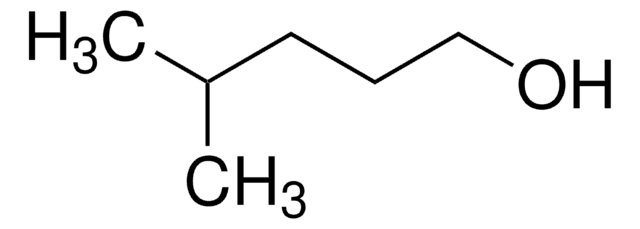320021
3-Methyl-1-butanol
ACS reagent, ≥98.5%
Sinónimos:
Isoamyl alcohol, Isopentyl alcohol
About This Item
Productos recomendados
grade
ACS reagent
vapor density
3 (vs air)
vapor pressure
2 mmHg ( 20 °C)
assay
≥98.5%
form
liquid
autoignition temp.
644 °F
expl. lim.
1.2-9 %, 100 °F
impurities
≤0.002 meq/g Titr. acid
≤0.1% carbonyl (as HCHO)
≤0.2% acids and esters (as amyl acetate)
≤0.5% water
evapn. residue
≤0.003%
refractive index
n20/D 1.406 (lit.)
pH
5.6 (20 °C, 25 g/L)
bp
130 °C (lit.)
mp
−117 °C (lit.)
density
0.809 g/mL at 25 °C (lit.)
SMILES string
CC(C)CCO
InChI
1S/C5H12O/c1-5(2)3-4-6/h5-6H,3-4H2,1-2H3
InChI key
PHTQWCKDNZKARW-UHFFFAOYSA-N
¿Está buscando productos similares? Visita Guía de comparación de productos
Categorías relacionadas
General description
Application
- Dissolution of a wide range of organic compounds and is often employed for extraction, dilution, and preparation of samples for analysis.
- Starting material or reagent in organic synthesis. It can be incorporated into various reactions to introduce the isoamyl group or alcohol functionality into target molecules.
signalword
Danger
hcodes
Hazard Classifications
Acute Tox. 4 Inhalation - Eye Dam. 1 - Flam. Liq. 3 - Skin Irrit. 2 - STOT SE 3
target_organs
Respiratory system
Storage Class
3 - Flammable liquids
wgk_germany
WGK 1
flash_point_f
110.3 °F - closed cup
flash_point_c
43.5 °C - closed cup
Certificados de análisis (COA)
Busque Certificados de análisis (COA) introduciendo el número de lote del producto. Los números de lote se encuentran en la etiqueta del producto después de las palabras «Lot» o «Batch»
¿Ya tiene este producto?
Encuentre la documentación para los productos que ha comprado recientemente en la Biblioteca de documentos.
Los clientes también vieron
Nuestro equipo de científicos tiene experiencia en todas las áreas de investigación: Ciencias de la vida, Ciencia de los materiales, Síntesis química, Cromatografía, Analítica y muchas otras.
Póngase en contacto con el Servicio técnico






